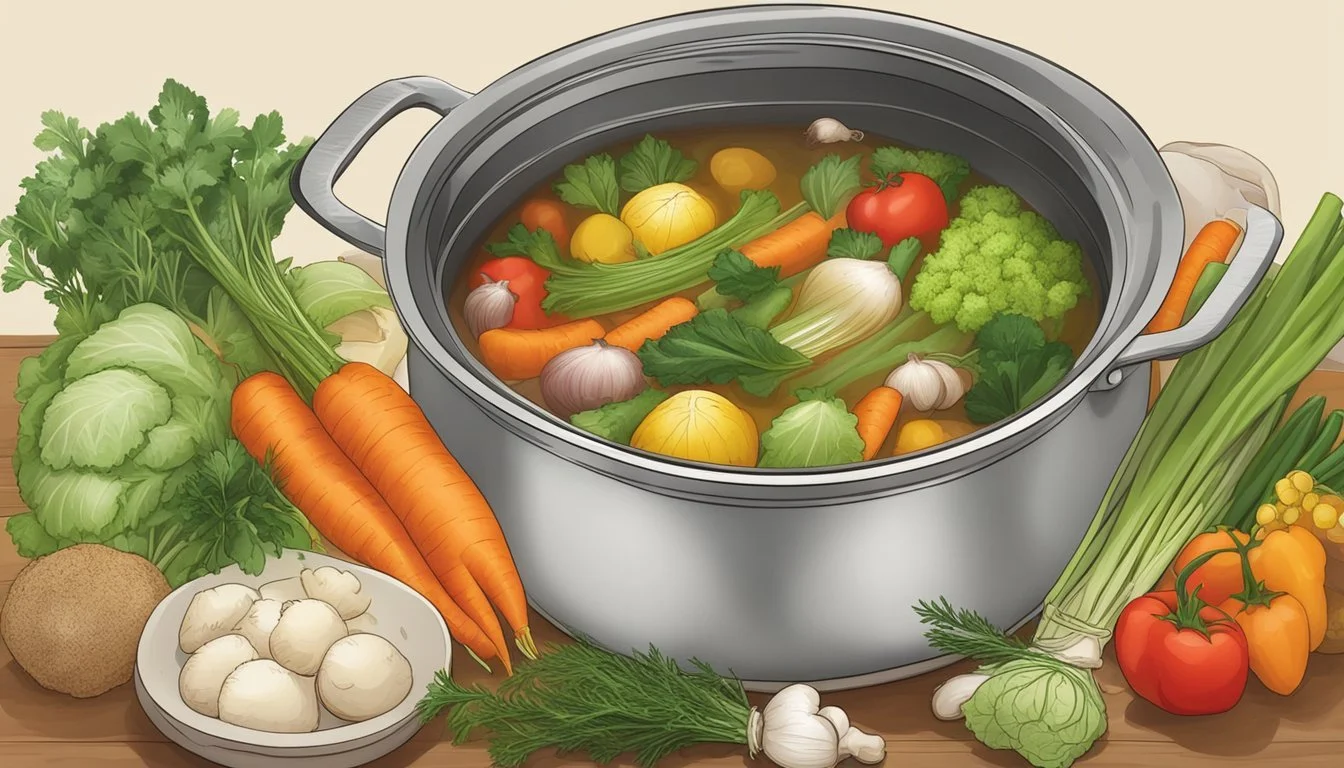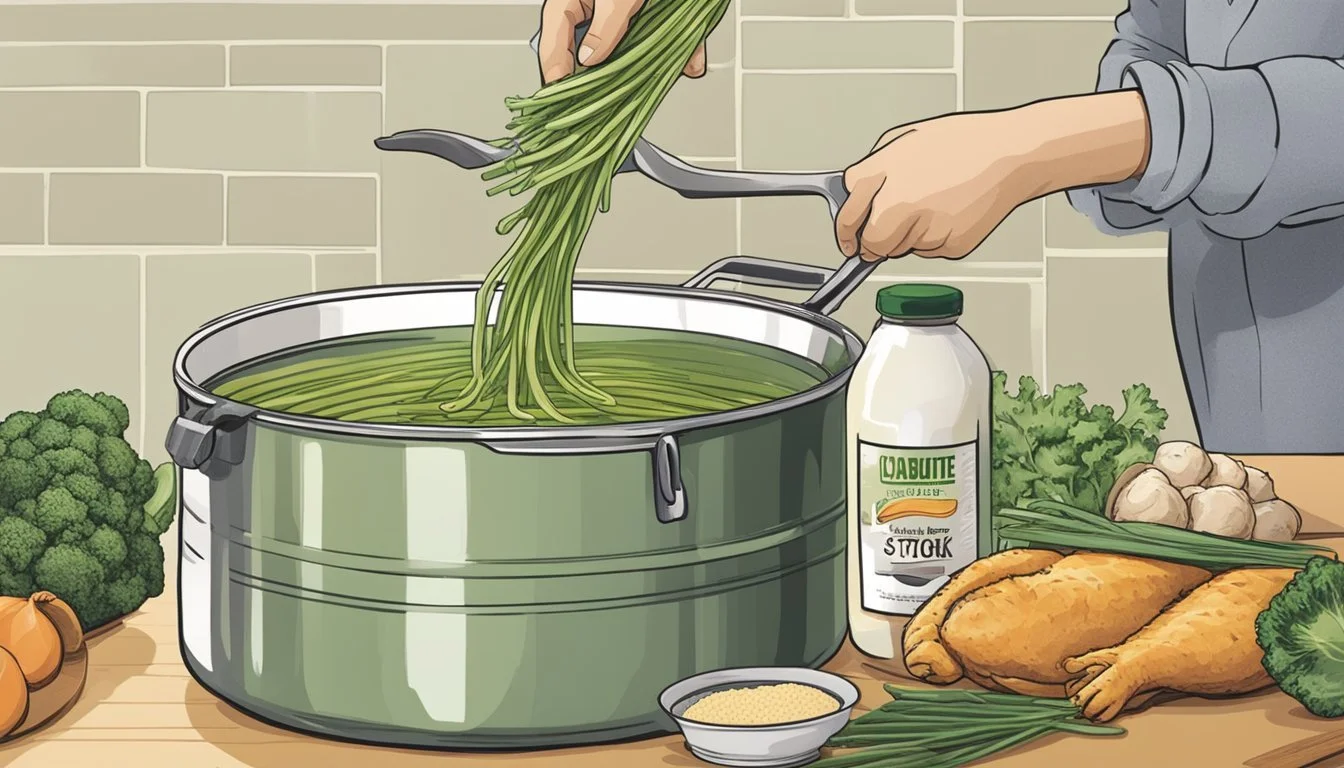How to Substitute Vegetable Stock for Chicken Stock
A Seamlessly Flavorful Swap
When preparing a dish that typically requires chicken stock, one might consider using vegetable stock as a substitute for various reasons, such as dietary preferences or simply due to the availability of ingredients. Vegetable stock is a versatile base in cooking that can replace chicken stock in most recipes. The key to a successful substitution lies in understanding the flavor profile of both stocks and how they interact with other components of the dish.
Vegetable stock brings a different set of flavors compared to chicken stock. It's often lighter, making it suitable for a wide range of dishes, from risottos to soups. When substituting vegetable stock for chicken stock, chefs should consider the type of vegetables used in the stock to ensure complementary flavors. A well-prepared vegetable stock can provide depth and a rich base without the need for meat-based stocks.
It is important to note that the substitution might slightly alter the taste of the final dish, but it does not diminish the quality. The ratio for substitution is typically one-to-one, making it a straightforward swap. Vegetable stock can seamlessly fit into the role of chicken stock, enhancing the dish with its unique flavor while maintaining the desired consistency and richness.
Understanding the Basics of Stock Substitution
When it's necessary to substitute vegetable stock with chicken stock, it's essential to understand their roles in recipes. Both stocks are foundational liquids used in cooking to enhance the flavor of dishes. Chicken stock, derived from simmering chicken bones and aromatic vegetables, tends to have a more robust, hearty flavor profile compared to its vegetable counterpart.
Vegetable stock, usually made from a blend of vegetables, herbs, and spices, is preferred for its lighter taste and suitability for those following vegetarian or vegan diets. When substituting with chicken stock, chefs need to be mindful of dietary restrictions, as it introduces meat-based elements into the dish.
The substitution process is straightforward:
1 cup of vegetable stock = 1 cup of chicken stock
However, when replacing vegetable stock, one must consider the change in flavor and nutrition. Chicken stock generally offers a richer mouthfeel and can contribute a depth of flavor that might not be desired in all vegetable-based recipes.
Vegetable Stock vs Chicken Stock
Aspect Vegetable Stock Chicken Stock Base Ingredients Vegetables, herbs, water Chicken bones, vegetables, water Flavor Mild, versatile Rich, savory Nutritional Value Low-calorie, fat-free Higher in protein, contains fat Suitability Vegan, vegetarian Non-vegetarian
Remember, the choice of substitute depends on the recipe and desired outcome. If substituting is necessary, adjust the seasoning and recipe composition to ensure the integrity of the dish remains intact.
Identifying Flavor Profiles
When substituting vegetable stock for chicken stock, understanding the distinct flavor components of each is crucial for a seamless transition in recipes.
Flavor Components in Chicken Stock
Chicken stock boasts a hearty, meaty essence derived chiefly from simmered bones, often with some meat remaining. Essential flavor contributors include:
Salt: Balances and enhances the natural flavors.
Aromatics: Typically includes onions, garlic, and celery (how long does celery last?).
Herbs and Spices: Thyme, bay leaves, and black pepper are common.
Flavor Components in Vegetable Stock
Vegetable stock provides a lighter, more herbaceous profile. It’s composed of a diverse vegetable base that typically incorporates:
Onions and Garlic: Offer a foundational pungency and depth of flavor.
Celery and Carrots: Add sweetness and earthiness, complementing the overall flavor.
Herbs: Parsley, thyme, or bay leaves are often infused for complexity.
A successful stock substitution pays close attention to these flavor components to maintain the intended taste of a dish.
Adjusting Seasonings and Aromatics
When substituting vegetable stock for chicken stock, one must carefully balance the seasonings and aromatic vegetables to achieve the desired depth of flavor.
Balancing Salt and Spices
Vegetable stock often has a milder flavor profile than chicken stock; therefore, it is essential to adjust the salt and spices carefully. A bouillon cube can be dissolved in water to create a base with an intensified flavor; use one cube per cup of water. When introducing herbs and spices such as bay leaf, black pepper, onion powder, or garlic powder, begin with small amounts and taste frequently:
Salt: Start with a pinch and increase to taste, aiming for a subtle enhancement of the stock's natural flavors.
Black Pepper: Freshly ground black pepper adds a piquant note; use sparingly to avoid overshadowing the delicate vegetable notes.
Herbs: A bay leaf contributes a subtle, earthy undertone. Add during the early stages of cooking to allow its flavor to permeate the stock.
Spices: Onion powder and garlic powder provide a concentrated burst of flavor. Use in 1/4 teaspoon increments to prevent overwhelming other ingredients.
Incorporating Aromatic Vegetables
Aromatic vegetables form the backbone of a rich and savory stock. The traditional mirepoix—an equal mix of onions, carrots, and celery—offers a balanced sweetness and vegetal depth. To further tune the flavor profile:
Onions: Enhance sweetness and complexity; sauté lightly for a richer color and taste.
Celery: Introduce a mild, slightly peppery taste with diced celery or a pinch of celery seed.
Carrots: Contribute natural sugars and a hint of earthiness; go easy to prevent the stock from becoming too sweet.
Dice these vegetables uniformly and sauté them gently before adding to the stock to unlock their full aromatic potential.
Alternative Ingredients for Flavor Enhancement
When substituting vegetable stock for chicken stock, a cook can enhance flavors using herbal and umami-rich additions. These alternatives can introduce depth and complexity to a dish.
Herbal Infusions
Herbs infuse vegetable stock with aromatic qualities that mimic the depth found in chicken stock. They include:
Thyme: Adds a subtle, earthy flavor.
Rosemary: Imparts a woody, citrus note.
Bay Leaves: Provide a hint of mint and clove.
By steeping these herbs in the vegetable stock, one can elevate the stock's flavor profile to closely resemble that of chicken stock.
Umami-Rich Additions
A key to mimicking chicken stock’s savoriness is leveraging ingredients with umami properties:
Soy Sauce: A little can add saltiness and a profound savory taste.
Miso Paste: Offers richness and a complex flavor.
Nutritional Yeast: Brings a cheesy and nutty profile, useful as a vegan alternative.
Bouillon Cubes:
Type Amount Notes Salted Bouillon Cube 1 cube Dissolve in hot water before adding. Vegan Bouillon Cube 1 cube For those seeking plant-based options.
These additions not only enhance the taste but also maintain the integrity of the stock as a base for various recipes. One can experiment with the quantities of these umami-rich additions to achieve the desired flavor intensity.
Reducing and Simmering Techniques
When substituting vegetable stock for chicken stock, the key lies in achieving a rich, full-bodied flavor. Reducing and simmering are crucial techniques to concentrate the stock's taste and mimic the depth found in chicken stock.
Creating Depth Through Reduction
In the substitution process, one begins by gently reducing the vegetable stock. This involves simmering the liquid on a low heat, allowing water to evaporate and flavors to intensify. The reduction should be slow and controlled, as a rapid boil can dissipate volatile aromatics that contribute to the depth of flavor. Depending on the recipe, whether it be for soup, stews, or sauces, reducing the stock by one-third can notably enhance its richness and body, bringing it closer to that of chicken stock.
Soup: Achieve heartiness in soups by reducing the stock before adding other ingredients.
Sauces: For a thicker consistency, reduce the vegetable stock until it reaches the desired intensity.
Stews (What wine goes well with stews?): Intensify the foundational flavors of stews with a moderately reduced stock.
Optimizing Simmering Time
Once reduced, the stock's simmering time is essential for flavor extraction. A long, low-heat simmer helps develop the stock's complexity, allowing flavors from the vegetable stock's components—such as onions, carrots, and celery—to meld. A suggested simmering time spans from 45 minutes to an hour. To further emulate chicken stock's distinct taste and body, consider incorporating a chicken broth concentrate.
For homemade stocks: Simmering homemade stocks can provide additional time for the natural flavors to merge and become more pronounced.
The techniques of reducing and simmering vegetable stock require patience but result in a flavorful substitute for chicken stock that doesn't compromise on taste or quality.
Utilizing Substitutes in Different Recipes
When a recipe calls for chicken stock, one can confidently substitute it with vegetable stock in a variety of dishes, maintaining the essence of the meal while catering to dietary preferences. The following subsections provide guidance on making these substitutions effectively in soups and stews, as well as sauces and gravies.
Soups and Stews
In recipes for soups and stews, vegetable broth can seamlessly replace chicken stock to accommodate vegetarians or those seeking a meatless option. The key is to ensure the substitute complements the flavor profile of the dish. For example:
Traditional chicken soup: Replace chicken stock with homemade vegetable stock, which can be bolstered with herbs like thyme and rosemary.
Beef stew: (What wine goes well with beef stew?) Opt for a robust store-bought vegetarian "chicken" stock to mimic the depth of flavor typically provided by its meat-based counterpart.
Sauces and Gravies
Sauces and gravies are fundamental components that enrich the main course, and altering their base can transform the final taste. When substituting for chicken stock in these recipes, one must select the appropriate vegetable stock to maintain the desired thickness and richness. For instance:
Gravy for meat dishes: A darker, richer homemade vegetable broth, possibly using roasted vegetables, is ideal for achieving the necessary savory quality.
Cream sauces: A lighter, well-strained vegetable broth would provide the necessary liquid consistency without overpowering other flavors in the sauce.
Specialty Substitutes and Unique Alternatives
When looking for specialty substitutes and unique alternatives to vegetable stock, one can consider both plant-based options for vegetarians and vegans, as well as certain types of alcohol for a distinctive flavor profile.
Vegetarian and Vegan Options
Coconut Milk: A vegan substitute that imparts a creamy texture and a hint of sweetness, ideal for Thai and Indian cuisines.
Aquafaba: The liquid from canned chickpeas can be used as a flavor enhancer and is vegan-friendly; it's best suited for dishes where a slight bean flavor complements the overall taste.
Alcohol-Based Alternatives
Beer: Working well in hearty stews, beer can provide a rich, yeasty depth to dishes. One should consider the beer's bitterness and opt for milder ales for a subtler taste.
Red Wine: Suitable for robust meals like risottos and gravies, red wine gives an acidic and fruity nuance. It's important to choose a wine that pairs well with the other flavors in the recipe.
Homemade Stock Tips and Tricks
Creating a rich and flavorful vegetable stock at home or enhancing a store-bought one can significantly improve a dish's depth of flavor. Here's how to excel at both.
Crafting Homemade Vegetable Stock
When making homemade vegetable stock, a cook should focus on a robust flavor foundation. Utilizing a combination of classic aromatic vegetables, such as onions, carrots, and celery, provides a well-rounded base. For a stock with a more complex flavor profile, one might incorporate mushrooms for an umami boost, akin to the depth found in homemade chicken stock. Aromatic herbs like thyme or bay leaves, and spices such as whole peppercorns, can be added for additional layers of flavor.
A critical consideration in stock-making is water quality, as it can influence the overall taste. If one's tap water is heavily chlorinated or has a distinct taste, using filtered or bottled water is advisable to ensure a clean, uncontaminated flavor. Another tip for enriching homemade stock is to include a splash of wine, which can brighten the stock and bring an extra dimension to its flavor. It's essential to keep the stock simmering gently, as a vigorous boil can result in a cloudy broth.
Essential Vegetables: Onions, carrots, celery
Umami Boosters: Mushrooms, tomato paste
Aromatic Herbs: Thyme, bay leaves
Spices: Peppercorns, garlic
Liquid: Filtered water, wine as needed
Enhancing Store-Bought Stocks
Even high-quality store-bought stocks can benefit from a personal touch to better suit one's cooking needs. They often serve as a convenient time-saver, but may lack the personalized flavor a homemade stock carries. To enhance them, one can simmer the stock with additional vegetables like green beans or a stick of cinnamon for a unique twist.
Incorporating fresh herbs and spices can significantly enhance the aroma and flavor of store-bought stock. Consider gently simmering with a bouquet garni — a bundle of herbs tied together — to infuse the stock with fresh flavors. If the stock is too thin, simmering it down can concentrate the flavors, resulting in a richer taste. Another method to add complexity is to stir in a small amount of mushroom stock, elevating the umami character akin to a homemade chicken stock's richness.
Additional Vegetables: Green beans, extra onions
Herbs and Spices: Bouquet garni, cinnamon
Concentration: Simmer to reduce volume
Umami Enhancement: Add mushroom stock
Nutritional Considerations and Adjustments
When substituting vegetable stock for chicken stock, one must consider the nutritional differences between these two broths. Vegetable stock typically caters to vegetarian and vegan diets, providing a plant-based alternative with a distinct profile of vitamins and minerals derived from vegetables.
Nutritional Yeast: A common addition to fortify the flavor of vegetable stock is nutritional yeast. It not only adds a savory, cheese-like taste, but also contributes additional B-vitamins and protein.
Nutrient Vegetable Stock Chicken Stock Calories Lower Higher Fat Generally lower Depends on preparation Protein Lower Higher Sodium Varies* Varies* Vitamin Content Higher in certain vitamins** Varied
*For those managing their sodium intake, low-sodium options of both stocks are available.
**Particularly vitamins A and C from the vegetables.
Salt Content: One should be aware that commercial vegetable broth can vary in salt content. Opting for low-sodium versions when available is a healthy practice, especially for individuals with dietary salt restrictions. This makes controlling the overall salt content of the dish easier as one can season according to taste and dietary needs.
When using chicken bouillon cubes or granules as a non-vegetarian substitute, the swap can result in a higher sodium content and a more intense flavor. It is recommended to adjust these amounts accordingly or seek low-sodium alternatives to match the nutritional profile of vegetable stock more closely.
Common Mistakes and How to Avoid Them
When substituting vegetable stock for chicken stock, cooks should be mindful of a few common pitfalls to ensure the flavor and quality of their dishes remain high, whether it's soup, stews, or sauces.
Not Adjusting Salt Content: Chicken stock can be saltier when compared to vegetable stock. When using a vegetable stock substitute, one should taste as they go and season to suit their dish's needs.
How to Avoid: Start with less seasoning and adjust accordingly after substituting.
Ignoring Flavor Profile: Vegetable stock often has a lighter, earthier flavor, potentially altering the desired taste of a dish originally calling for chicken stock.
How to Avoid: Consider the recipe's flavor goals and choose a vegetable stock with complementary herbs and vegetables.
Overlooking Dish Type: Different dishes react uniquely to stock substitutes. For example, a robust stew might require a richer substitute than a light soup.
How to Avoid: Tailor the substitute to match the dish's intensity; consider mushroom broth or adding a chicken base for richer dishes.
Table of Substitution Ratios
Dish Type Recommended Substitute Ratio Light Soups 1:1, vegetable stock to recipe requirement Hearty Stews 1:1, consider fortifying with soy sauce or a splash of wine Sauces 1:1, potentially reduce or simmer to concentrate flavors
By recognizing these typical mistakes and taking steps to prevent them, cooks can effectively use vegetable stock as a chicken stock substitute without compromising on flavor or texture.
Frequently Asked Questions
Can I directly substitute vegetable stock for chicken stock?
Yes, vegetable stock can be directly substituted for chicken stock in a 1:1 ratio. It is a suitable stand-in that provides a vegetarian option for recipes.
What are the best vegetable stock substitutes for chicken stock?
Vegetable Stock Substitutes:
Beef Stock/Broth: Can replace chicken stock, adding a rich, hearty flavor.
Dashi: A Japanese stock made from fish or kelp; use when a hint of umami is desired.
Bone Broth: Has a similar texture to stock with a deep flavor.
Will the taste of my dish change if I use vegetable stock instead of chicken stock?
Yes, the taste will differ slightly. Chicken stock imparts a distinct poultry flavor, whereas vegetable stock offers a milder taste. Seasoning adjustments may be necessary.
Is there an equivalent to chicken bouillon in vegetable form?
Vegetable Bouillon cubes or granules are available as an alternative to chicken bouillon. Use according to package instructions to reconstitute into vegetable stock.
Can I use gelatin to thicken vegetable stock as a substitute?
While gelatin is often used in meat-based stocks to add body, many vegetable stocks lack the natural collagen that creates this effect. Agar-agar or plant-based thickeners could be a vegetarian-friendly option to achieve a similar consistency.
If I don't have vegetable stock, what other substitutes can I use?
Other Substitutes:
Water: In a pinch, plain water can be used, though flavor enhancements might be necessary.
Herb-infused Water: Simmering water with herbs can introduce flavors lacking from the absence of stock.









